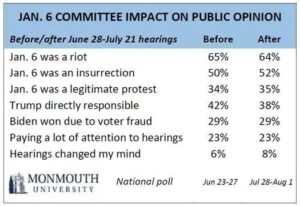A few tips from, “Is This When Democrats Finally Learn How to Message? Republicans have been running circles around Democrats for decades. But finally the right has handed them a potent weapon. Will they recognize it and use it?” by Michael Sokolove at The New Republic:
“Sell the brownie, not the recipe,” is the top-line advice that [progressive candidate strategist Anat] Shenker-Osorio gives to her clients. She has consulted for various candidates and organizations, both overseas and in the United States, including the Senate Democratic Caucus. She tries to coax progressives out of their long-windedness—their instinct to aim messages at the head rather than the heart—and their tragic inability to get to the point.
“I want them to say fewer things and say them more often,” she said. “But Democrats get bored with that. They’re not good at it. I say this with so much sadness, but Elizabeth Warren spent an entire campaign selling the recipe rather than the brownie. I tell people: Don’t take your policy out in public. It’s not seemly. Your policy is not your message. The message is the outcome of your policy. For example, ‘We’re going to give you family leave so you’re going to be there the first time your baby smiles. We’ll raise the minimum wage so you can put food on your table, and you’ll be home to eat dinner with your family.’”
Drawing a contrast between the messaging style of the two major parties, Sokolove notes,
….The two major parties “do not operate as simple mirror images,” the political scientists Matt Grossman and David Hopkins observe in their 2016 book, Asymmetric Politics: Ideological Republicans and Group Interest Democrats. They write that even as Democrats have moved to the left on certain social issues, the party’s governing style can be described as “technocratic incrementalism over one guided by a comprehensive value system.” Democratic voters largely expect their elected officials to compromise—both among themselves, and, where possible, with the opposing party.
Is there an important distinction to be made between messaging by Democratic candidates on the one hand and progressive groups on the other?
….Steven Greene is a professor of political science at North Carolina State University with an expertise in public opinion and elections. When I told him the questions I was exploring, he responded by highlighting the divisions in the Dem tribe: “Are Democrats horrible at messaging? No. Liberal advocacy groups, who are not trying to win elections, are horrible at it. They’re the ones talking about ‘chest feeding,’ the ones arguing for Lia Thomas and other trans athletes to compete against women.” Establishment Democrats, he continued, “did not argue for defunding the police or use that phrase. But the left and its organized groups do. These are deeply unpopular opinions.” The party, he said, is currently engaged in “generational warfare. They’re eating themselves from the inside.”
Regarding the allegation that people who vote for Republicans do so against their self-interest,
There’s a raft of political science research that voters, and maybe especially Republican voters, are led by emotion as much as rationality. They go with the team they feel is pulling for them. Is it really voting against their self-interest when they cast ballots to put people in office who speak their language and make them feel better?….“When it’s said that people are voting against their self-interest, it’s a mistake to define self-interest in purely economic terms,” said Laurel Elder, a political science professor at Hartwick College in Oneonta, New York, and the co-author, with Steven Greene, of The Politics of Parenthood. “They vote on emotion, on what gives meaning to their lives.”
Sokolove also taps the insights of a top Republican wordsmith, and writes:
Freedom is one of the big words that Republicans have owned. “Democrats don’t want to talk about religion, faith, and freedom,” [Republican strategist Frank] Luntz told me. “That comes off the Republican tongue like butter. Democrats choke on it.”….Freedom, though, is the winning word for Democrats. It is the beacon that brought immigrants pouring into this country. In its fullest form, it is what the descendants of enslaved Africans have fought for over the whole of the nation’s 246-year history. It’s the through line for the nation’s proudest accomplishments and purest ambitions.
Freedom for women to have control over their own choices and bodies. Freedom to vote. Freedom to love who you want. Freedom to read what you want. Freedom to earn a living wage. Freedom to send your children off to school without fear they’ll be riddled with bullets from an AR-15. Freedom for your kids and grandkids to dwell on a livable planet.
As Sokolove concludes, “Sell the brownie, not the recipe—and see how that works.”




